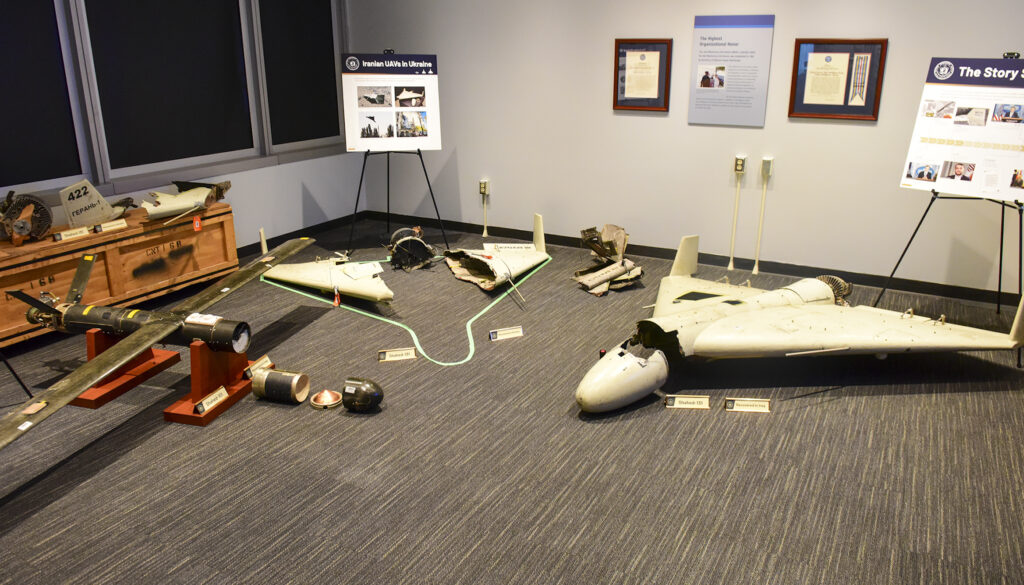The United States announced on Tuesday it had confirmed the Houthis have been using the same Iranian drones, among other Tehran-supplied weapons, as the ones they previously provided to Russia for use in Ukraine.
The Defense Intelligence Agency confirmed in a newly released report that the Iranians have provided the Houthis with various one-way unmanned aerial vehicles, different medium-range ballistic missiles, land-attack cruise missiles, and surface-to-air missiles. The agency was able to compare public photos shared by the Houthis of their arsenal to similar ones published by Iran to confirm the weapons are the same despite being renamed.
The DIA found that the Waid 2 Houthi drone, which was first showcased at a March 2021 exhibit in Sanaa, Yemen, shares “nearly identical features with the Iranian Shahed-136,” including the same wing stabilizers, a short nose cone, pitot tubes, and a tube-like fuselage. The Houthis’ Waid 1 is consistent with Iran’s Shahed-131.

The Houthis, one of Iran’s proxies in the Middle East, have carried out more than 40 attacks on commercial vessels in the waterways off Yemen’s coasts since mid-November. They continue to carry out these attacks, or try to, despite multiple U.S. military responses. Houthi leaders have said the attacks are in response to Israel‘s war against Hamas in Gaza, while the rebel group has been able to rally domestic support for their cause.
Other Iranian weapons systems the DIA could confirm the Houthis have displayed include the Sammad one-way attack drone, the Burkan-3 medium-range ballistic missile (MRBM), the Houthi Burkan ballistic missile, the Toofan ballistic missile, the Hatem ballistic missile, the Karar ballistic missile, the Asif anti-ship ballistic missile, the Tankeel ballistic missile, the Quds-4 series land-attack cruise missiles (LACMs), and the Saqr surface-to-air missile (SAM).
“Since 2014, Iran’s Islamic Revolutionary Guard Corps-Qods Force (IRGC-QF) has provided the Houthis a growing arsenal of sophisticated weapons and training that they have used to attack commercial shipping in the Red Sea and civilian port and energy infrastructure across the region,” the report said
Last year, the agency confirmed that Iran had provided hundreds of the Shahed-131 and Shahed-136 to Russia, which they used to target Ukraine’s infrastructure. They were able to make the determination that Iran had provided the Shahed-131, renamed Geran-1 by the Russians, and Shahed-136, renamed Geran-2, to Moscow by comparing the remnants of ones recovered from the battlefield in Ukraine to one found in Iraq after an attack the Iranians claimed they were behind in 2021.
“Iran has successfully identified and exploited a niche market for these low-cost single-purpose attack drones,” LTC Robert Carter, a DIA spokesman, told the Washington Examiner back in August.
Iran’s military support for U.S. adversaries continues to grow and raises concerns.
“In total, Iran is seeking billions of dollars worth of military equipment from Russia to strengthen its military capabilities. Russia has also been helping Iran develop and maintain its satellite collection capabilities and other space-based programs,” NSC coordinator John Kirby told reporters in November.
“Russia has been offering Tehran unprecedented defense cooperation including on missiles, electronics, and air defense. Earlier this year, Iran announced it had finalized a deal to buy Su-35 fighter jets from Russia,” Kirby added. “Iran is seeking to purchase additional military equipment from Russia, including attack helicopters, radars, and combat trainer aircraft.”
The Houthis are not the only members of Iran’s “axis of resistance,” the group of autonomous militia groups they support, fund, and train throughout the Middle East that have carried out attacks against U.S. interests in the Middle East in recent months.
CLICK HERE TO READ MORE FROM THE WASHINGTON EXAMINER
Among their proxies are Iraqi militias that have carried out roughly 170 attacks against U.S. forces in Iraq, Syria, and Jordan since mid-October. Three U.S. troops have been killed in the attacks, while more than 140 service members have been wounded.
The U.S. has carried out a series of attacks against these militias, including, most recently, their response to the deaths of the three troops in an attack on Jan. 28. U.S. officials have said their response will occur in multiple iterations, while only the initial one has taken place so far.

